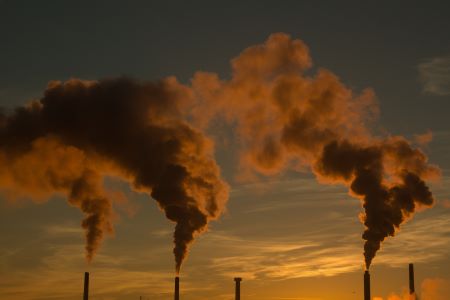Government policies “totally inadequate” for Canada to achieve net zero, new report says
 Canada needs much more aggressive policies immediately to have any hope of achieving the federal government’s target of net-zero greenhouse gas emissions by 2050, according to a new report.
Canada needs much more aggressive policies immediately to have any hope of achieving the federal government’s target of net-zero greenhouse gas emissions by 2050, according to a new report.
“The current state of government policy is totally inadequate to achieve net zero,” report author David Hughes (photo below) told Research Money. “The challenges are insurmountable, with current policy.”
The report, “Getting to Net-Zero in Canada,” by the Canadian Centre for Policy Alternatives - BC Office, says achieving net zero will require massive changes in Canada’s energy system within the next 2 ½ decades, including:

- major cuts in oil and natural gas production (up to 75 per cent for oil and up to 68 per cent for gas)
- increasing electricity’s share of energy supply to 55 per cent, from 17.6 per cent in 2022
- a carbon price of at least $400 per tonne (compared with $65 per tonne in 2023)
- reductions of 33 to 41 per cent in per-capita energy consumption
- a near-tripling of nuclear power
- more than a 10-fold increase in renewable energy generation from wind and solar
- a scaleup of hydrogen from essentially nothing to 11 per cent of energy consumption
- a six-fold increase in biomass utilization for energy.
In addition, according to Hughes’s report, carbon capture and storage will need to increase 34 to 39 times from current levels, direct air carbon capture technology will need be scaled several thousand-fold, and major improvements made in forest management practices to not only restore but triple the carbon sequestration capacity of Canada’s forests. These forests are currently significant net emitters of GHG emissions due to worsening wildfires.
“The status quo cannot continue. Canada’s policies must be much more aggressive in order to achieve its emissions reduction mandate,” said Hughes, an earth scientist and former research manager with the Geological Survey of Canada for 32 years. Since 2008, he has been president of Global Sustainability Research, a consultancy firm.
GHG emissions in Canada had dropped only 8.5 per cent as of 2021, according to Hughes’s report. For Canada to meet its goal of 40 per cent to 45 per cent emissions reduction, compared with 2005 levels, by 2030, the rate of emissions reduction must increase by about seven times over the 2022 to 2030 period, compared with the rate between 2005 and 2021, he said. This must be followed, he added, by an emissions reduction increase of more than five times from 2031 to 2050 to achieve net zero.
“Polices in place as of March 2023 would reduce emissions by only 16 per cent of 2022 levels by 2050,” Hughes said. “They must be greatly strengthened to have any hope of reaching net zero.”
The government approving construction of new oil and gas infrastructure, such as liquified natural gas (LNG) export terminals, significantly increases the risk that Canada’s net-zero mandate won’t be achieved, he said.
Despite Canada’s emissions-reduction targets, oil and gas production is at an all-time high and will rise further when the federal government-owned Trans Mountain pipeline is completed this year and the first of four approved LNG terminals comes on stream, he said.
In his report, Hughes analyzed the Canada Energy Regulator’s (CER) June 2023 report, “Canada’s Energy Future 2023,” which contained – for the first time – projections of energy supply in scenarios that would meet Canada’s net-zero emissions reduction target by 2050.
The CER’s net-zero scenarios are based on an economic analysis of current and announced government policies, technical factors and the most comprehensive knowledge base of Canadian energy data available and they illustrate the scale of the challenge to reach net-zero, Hughes said.
While assumptions in the CER’s net-zero scenarios are optimistic in terms of declining costs of emerging net-zero technologies and how soon they could be deployed, net zero will be achieved only with significant action driven by much more aggressive policies, he said.
For Canada to have a realistic chance of reaching its net-zero target by 2050, compared with the CER net-zero scenarios and their forecasts, it will mean:
- Less reliance on fossil fuels which will reduce the need for expensive carbon capture, storage and carbon removal to more realistic levels.
- A greater proportion of electricity in the energy mix, including more renewable energy generation, to compensate for significantly reduced fossil fuel use.
- A greater emphasis on energy efficiency and reducing energy consumption at all levels.
“Although meeting Canada’s net-zero mandate will necessitate unprecedented change, failure to do so would be much worse,” Hughes said.
Deep cuts in oil and gas production needed
Deep production cuts in oil and natural gas will be required because it’s too risky to rely on a huge increase in carbon capture and storage (CCS) – including with direct air capture technology – and new nuclear power and hydrogen, according to Hughes’s report.
To achieve net zero, Canada would have to increase CCS projects by 34 to 39 times by 2050, including deploying direct air capture at 4,600 to 5,500 times current world capacity, his report says.
Even steeper cuts in the production and use of fossil fuels will be required than in the Canadian Energy Regulator’s (CER) net-zero scenarios, to reduce the need for expensive CCS technology, according to the report.
Compared with fossil fuels production cuts in the CER scenarios, the International Energy Agency’s net-zero roadmap said fossil fuels will need to be reduced to just 19 per cent of end-use energy demand by 2050.
In 2022, fossil fuels met 77.4 per cent of Canada’s end-use energy demand, with the country exporting 63 per cent of its oil and 34 per cent of its natural gas, according to Hughes’ report. The energy sector contributed 8.9 per cent of Canada’s overall GDP. Among the provinces, the sector contributed to 31 per cent of Alberta’s GDP, 30 per cent of Newfoundland and Labrador’s, and 21 per cent of Saskatchewan’s.
But to achieve net zero, based on the CER’s scenarios, Canada’s oil production will need to decline – within the next 2 ½ decades – by 21 to 75 per cent. This includes declines of up to 93 per cent in in situ bitumen production from Alberta’s oilsands and up to 79 per cent in mined bitumen production.
Natural gas production will need to decline by 37 to 68 per cent from 2022 levels by 2050, based on the CER’s scenarios. In the global net-zero scenario, the LNG Canada terminal under construction in Kitimat, B.C. must be shut down in 2045 – 20 years before its design lifespan – stranding the $48.3 billion spent on the terminal and the Coastal Gas Link pipeline built to supply it, Hughes’s report says.
Along with these sharp declines in oil and gas production would be a precipitous drop in provincial and federal revenues from producing and exporting oil and gas – although Hughes’s report doesn’t say how much.
Canada’s oil production has nearly tripled since the early 1980s and 63 per cent of production was exported in 2022, mainly to the U.S., the report noted.
Alberta’s oil production has doubled since 2010 and the GDP contribution of the province’s energy sector has increased by 44 per cent, due almost exclusively to the expansion of the oilsands, one of the most emissions-intensive sources of oil in the world, the report says.
Similarly, British Columbia’s energy sector GDP has increased 34 per cent since 2010 as the province’s natural gas production doubled, largely through development of the very large Montney play in northeast B.C. – made possible by the advent of high-volume hydraulic fracturing (fracking).
The provinces aren’t likely to willingly give up their oil and gas revenues, with Alberta Premier Danielle Smith and other critics already complaining that the federal government’s proposed cap on oil and gas industry emissions is essentially a production cut.
Asked how Ottawa could persuade the provinces to do it, Hughes noted that the CER’s net-zero scenarios would require the federal government to raise the price of carbon another $330 to $380 per tonne – beyond the $140 per tonne now scheduled for 2030.
Contribution by nuclear, hydrogen technologies is “extremely optimistic”
Fossil fuels production in Canada has more than doubled since 1990, which has made upstream production, refining and transportation of oil the largest source of Canada’s emissions, Hughes’s report says. Annual emissions from the oil and gas sector have grown from 100 million tonnes (Mt) to 189 Mt per year since 1990 and made up 28 per cent of Canada’s emissions in 2021, the most recent year for which data are available.
To replace the significantly reduced production and use of fossil fuels required to achieve net zero, Canada will need a much higher proportion of new electricity – including from wind and solar – than the 39 to 41 per cent increase assumed in the CER net-zero scenarios, according to Hughes’s report.
Increasing electricity’s share of energy supply to 55 per cent, as assumed in the International Energy Agency’s net-zero roadmap, “would be a more realistic target,” his report says. Experts have pointed out that achieving net zero would require at least a tripling of the existing national electricity grid infrastructure and cost many billions of dollars.
When it comes to cutting greenhouse emissions using small modular nuclear reactors (SMRs), Hughes pointed out that there are only six SMRs in the world operating or under construction. In Canada, one SMR is planned for construction at the Darlington, Ontario nuclear site and three more SMRs might be built by the mid-2030s.
The biggest SMR produces about 300 megawatts of power. “If every new reactor in Canada was a 300-megawatt SMR, we’d need 80 or more of those by 2050. I would rate that as extremely optimistic,” Hughes said.
As for turning to hydrogen for fuel and power generation – which would produce no emissions – the Canada Energy Regulator’s net-zero scenarios assumed hydrogen would increase to 11 to 12 per cent of end-use energy demand by 2050. But that forecast “is extremely optimistic,” given that hydrogen production for fuel and power is essentially zero now in Canada, Hughes said.
“Overreliance on hydrogen introduces high risk,” his report says. Hughes said a more realistic expectation is that hydrogen might account for five per cent of end-use energy demand by 2050.
Hughes’s report recommends maximizing the reduction of energy through conservation, efficiency and behaviour change, to reduce the need for costly energy production and carbon capture and storage infrastructure.
“This should be at the forefront of government policy incentives,” he said. “Maximizing reduction of energy consumption should become a major focus of government policy in the quest to meet net-zero commitments.”
Hughes said energy consumption could be reduced by:
- More mass transit infrastructure and effective commuting for essential travel.
- Reducing business travel as much as possible and non-essential travel in general.
- Encouraging more work remotely, to reduce energy use in commuting.
- Electrification in industry wherever possible.
- Much stronger building codes to maximize thermal efficiency, along with incentives to retrofit the thermal envelopes of existing buildings and for heat pumps.
- Localizing supply sources and reducing long supply lines, which lowers energy costs.
- Increasing use of rail transport for longer distances.
A thorough analysis in all sectors is needed to prioritize doing the lowest-cost opportunities that have the biggest impacts first, Hughes said.
A Conservative government would be “disastrous” for net-zero ambitions
The federal government is not on track to meet its target to reduce greenhouse gas emissions by at least 40 per cent below the 2005 levels by 2030, Canada’s Commissioner of the Environment and Sustainable Development said in a November 2023 report. Some of the most important mitigation measures to reduce emissions have been delayed, while the measures most critical for reducing emissions haven’t been identified or prioritized, Commissioner Jerry DeMarco said.
But Environment and Climate Change Canada, in a progress report released in December last year, insisted that “Canada remains firmly on track to meet our ambitious but achievable 2030 target.”
For Justin Trudeau’s Liberal government, achieving net zero by 2050 is a top priority. In addition to the carbon price, the government continues to invest heavily – both in terms of policies and public money – to make the energy transition.
However, Conservative Party leader Pierre Poilievre has vowed to scrap the carbon price if his party takes power in the next federal election in 2025. Currently, the Conservatives are polling far ahead of the Liberals in Canadians’ preference to form the next government.
Research Money asked Hughes how a Conservative government might change the assumptions in the Canadian Energy Regulator’s net-zero scenarios, and the dramatic shift to much more aggressive policies to achieve net zero that he recommends in his report.
“The political mindset of the Conservatives would be a disaster for Canada’s net-zero ambitions,” Hughes responded.
Half of the oil consumed by the human race during the last 300,000 years has been burned in the past 27 years, and half of the natural gas in the past 21 years, he noted. Canada’s emissions, on a per capita basis, are three times higher than the world’s average.
Fossil fuels are a finite resource and, at the current rate of consumption, the world will run out of easily accessible fossil fuel resources within a few decades at most, the longtime geologist said.
Hughes said the alternative to a planned orderly descent in fossil fuels use to achieve net- zero emissions “is collapse, basically. If we just keep going at this rate, the planet is going to be much warmer, biodiversity is going to be much worse than it is now. Everything will be much worse for future generations.”
“If we wait 10 years, it’s going to be much worse,” Hughes said. “So the easiest route is to start now.”
R$
Events For Leaders in
Science, Tech, Innovation, and Policy
Discuss and learn from those in the know at our virtual and in-person events.
See Upcoming Events
You have 0 free articles remaining.
Don't miss out - start your free trial today.
Start your FREE trial Already a member? Log in
By using this website, you agree to our use of cookies. We use cookies to provide you with a great experience and to help our website run effectively in accordance with our Privacy Policy and Terms of Service.





.jpg)